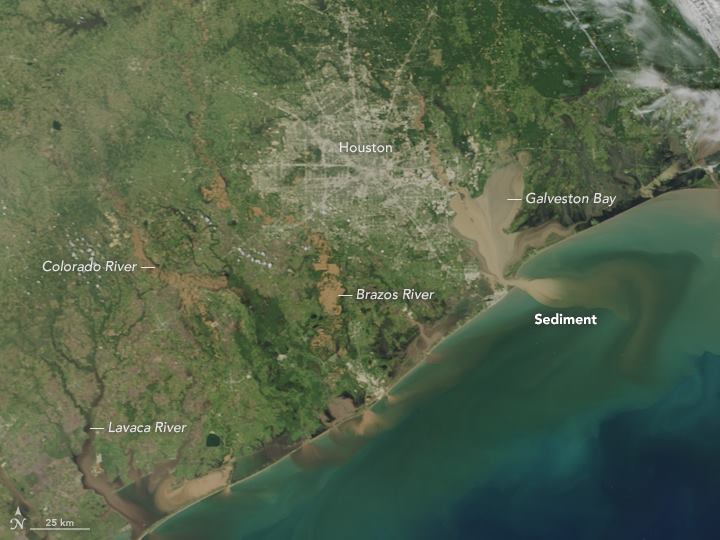How Has Harvey Impacted Water Quality?
- December 10, 2019
- News

Photo: NASA Satellite of brown rivers and Galveston Bay full of floodwater from Hurricane Harvey.
In the Houston area, stormwater from large flood events wash pollutants, chemicals and debris down our storm drains, into our bayous and eventually into Galveston Bay. The longer between rain storms or the more intense a rain storm, the more pollutants are washed into the water. However, major rain events have short term, and potentially long term, impacts on water quality.
So how has Hurricane Harvey impacted water quality? Galveston Bay Foundation’s volunteer water quality monitors mobilized after the storm to help us better answer this question. Read on to find out what they tested, what the results have been so far, and view a map of their monitoring locations.
Fecal Bacteria
Fecal bacteria generally spikes to high levels after heavy rain events. These bacteria are found in untreated sewage as well as in pet and animal waste. During major storms, sewage infrastructure often malfunctions, causing an increase in untreated sewage entering our streets and waterways. Stormwater will also wash any pet waste on lawns into public waterways. Exposure to these bacteria can cause gastro-intestinal sickness and other health issues.
What our water quality monitors found:
In general, GBF volunteer water monitors have found that while most spikes in these bacteria occur after major rain events, they tend to die off within three to four days.
Bacteria sampling began this past Monday, September 4, after GBF opened its lab for processing. So far, the collected water samples have had low values of bacteria.
While it is almost certain bacteria levels were high right after Harvey, over a week has passed since the storm hit. This shows that bacterial runoff into the Bay is declining; Galveston Bay is beginning to bounce back from the damage inflicted by Harvey. Additionally, Harvey poured such an immense amount of water on the Houston area that the sheer volume of water could have further diluted some of the bacteria it washed into Galveston Bay, reducing its initial concentrations.
To date, the samples collected around Galveston Bay have had concentrations of bacteria between 10-40 Most Probable Number (MPN). The EPA limit that it considers safe for swimming is 104 MPN. While this is a good sign for Galveston Bay right now, these results may not be the same for many of Houston’s bayous, which are still being impacted by flood waters and have less of a potential for dilution. The flood waters in the bayous could potentially impact the Bay in the future.
Salinity
Plant and animal life within the Bay rely on a specific range of salinity; water that is too fresh makes it difficult for life to thrive in Galveston Bay. Water that remains too fresh or too salty will impact growth and reproduction rates, can increase the prevalence of disease, and can ultimately impact their survival.
What our water quality monitors found:
The low salinity values GBF volunteer monitors have found around the Bay have been less reassuring than bacteria level results. Galveston Bay’s waters are currently much more fresh than they should be. Much of the unprecedented amount of rainfall that Harvey dumped on the region is finding its way into Galveston Bay, diluting any saltwater entering from the Gulf of Mexico. Many volunteers have commented that salinity levels the past week have been the lowest they have ever seen in years of testing. This is not good for life in Galveston Bay.
Turbidity/Debris
Turbidity is how clear the water is. This can have an impact on planktonic and plant life in the Bay, which may impact the health of other animals as well.
What our water quality monitors found:
We are finding that an increase in particulate matter in the water is making the water less clear. Water levels are also higher than normal, and of course much more debris has been observed in the water. One water quality monitor even observed a plastic Barbie doll floating in the water at their site!





